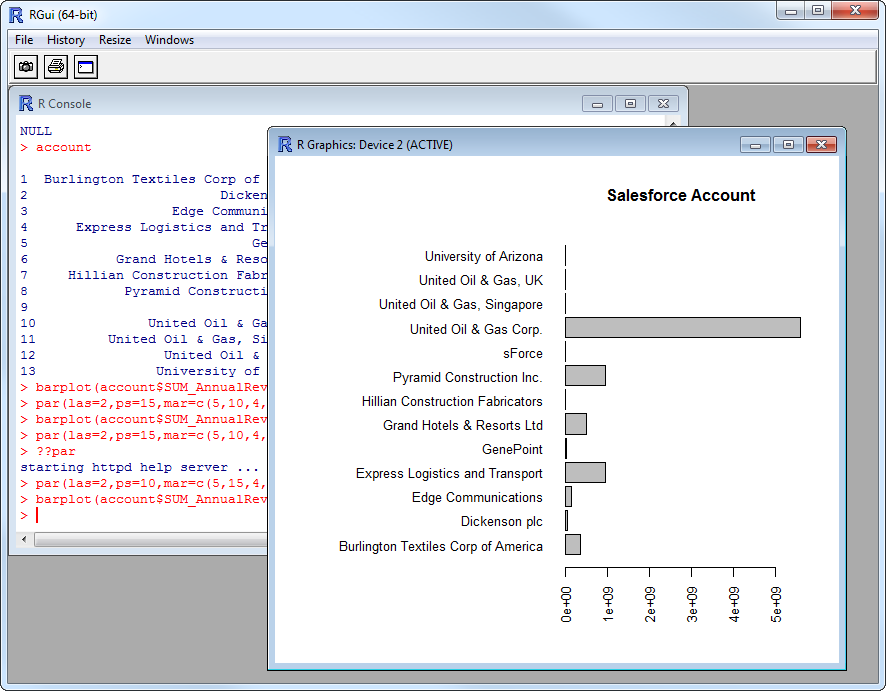Discover how a bimodal integration strategy can address the major data management challenges facing your organization today.
Get the Report →Analyze Airtable Data in R
Use standard R functions and the development environment of your choice to analyze Airtable data with the CData JDBC Driver for Airtable.
Access Airtable data with pure R script and standard SQL on any machine where R and Java can be installed. You can use the CData JDBC Driver for Airtable and the RJDBC package to work with remote Airtable data in R. By using the CData Driver, you are leveraging a driver written for industry-proven standards to access your data in the popular, open-source R language. This article shows how to use the driver to execute SQL queries to Airtable and visualize Airtable data by calling standard R functions.
Install R
You can match the driver's performance gains from multi-threading and managed code by running the multithreaded Microsoft R Open or by running open R linked with the BLAS/LAPACK libraries. This article uses Microsoft R Open 3.2.3, which is preconfigured to install packages from the Jan. 1, 2016 snapshot of the CRAN repository. This snapshot ensures reproducibility.
Load the RJDBC Package
To use the driver, download the RJDBC package. After installing the RJDBC package, the following line loads the package:
library(RJDBC)
Connect to Airtable as a JDBC Data Source
You will need the following information to connect to Airtable as a JDBC data source:
- Driver Class: Set this to cdata.jdbc.airtable.AirtableDriver
- Classpath: Set this to the location of the driver JAR. By default this is the lib subfolder of the installation folder.
The DBI functions, such as dbConnect and dbSendQuery, provide a unified interface for writing data access code in R. Use the following line to initialize a DBI driver that can make JDBC requests to the CData JDBC Driver for Airtable:
driver <- JDBC(driverClass = "cdata.jdbc.airtable.AirtableDriver", classPath = "MyInstallationDir\lib\cdata.jdbc.airtable.jar", identifier.quote = "'")
You can now use DBI functions to connect to Airtable and execute SQL queries. Initialize the JDBC connection with the dbConnect function.
APIKey, BaseId and TableNames parameters are required to connect to Airtable. ViewNames is an optional parameter where views of the tables may be specified.
- APIKey : API Key of your account. To obtain this value, after logging in go to Account. In API section click Generate API key.
- BaseId : Id of your base. To obtain this value, it is in the same section as the APIKey. Click on Airtable API, or navigate to https://airtable.com/api and select a base. In the introduction section you can find "The ID of this base is appxxN2ftedc0nEG7."
- TableNames : A comma separated list of table names for the selected base. These are the same names of tables as found in the UI.
- ViewNames : A comma separated list of views in the format of (table.view) names. These are the same names of the views as found in the UI.
Built-in Connection String Designer
For assistance in constructing the JDBC URL, use the connection string designer built into the Airtable JDBC Driver. Either double-click the JAR file or execute the jar file from the command-line.
java -jar cdata.jdbc.airtable.jar
Fill in the connection properties and copy the connection string to the clipboard.

Below is a sample dbConnect call, including a typical JDBC connection string:
conn <- dbConnect(driver,"jdbc:airtable:APIKey=keymz3adb53RqsU;BaseId=appxxN2fe34r3rjdG7;TableNames=Table1,...;ViewNames=Table1.View1,...;")
Schema Discovery
The driver models Airtable APIs as relational tables, views, and stored procedures. Use the following line to retrieve the list of tables:
dbListTables(conn)
Execute SQL Queries
You can use the dbGetQuery function to execute any SQL query supported by the Airtable API:
sampletable_1 <- dbGetQuery(conn,"SELECT Id, Column1 FROM SampleTable_1 WHERE Column2 = 'SomeValue'")
You can view the results in a data viewer window with the following command:
View(sampletable_1)
Plot Airtable Data
You can now analyze Airtable data with any of the data visualization packages available in the CRAN repository. You can create simple bar plots with the built-in bar plot function:
par(las=2,ps=10,mar=c(5,15,4,2))
barplot(sampletable_1$Column1, main="Airtable SampleTable_1", names.arg = sampletable_1$Id, horiz=TRUE)






